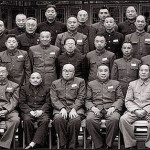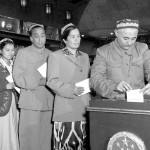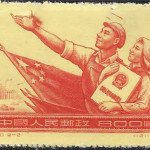
By the autumn of 1949, the communist victory was almost complete and the last remnants of the Nationalist army were being driven from China’s mainland. On October 1st Mao Zedong addressed a mass rally in Beijing, where he declared victory in the Civil War and the birth of a new nation: the People’s Republic of China (PRC). In his speech, Mao hinted at the organisation of his government. He declared the formation of a new political congress containing “all the democratic parties and people’s organisations of China, the People’s Liberation Army [and] the various regions and nationalities of the country”. This new body, Mao promised, would “represent the will of the people”. In the five years that followed, Mao and his cohort developed a new political system based on a constitution, a representative legislature and a court system. This new system, despite its theoretical promise, came to represent the will of the Chinese Communist Party (CCP) rather than the “will of the people”.
Like the National Assembly in France (1789) and the Bolsheviks in Russia (1917), the new government in China faced a raft of problems and challenges. China had been ravaged and exhausted by decades of warlordism, Japanese imperialism, war and civil war. Around one third of China’s critical infrastructure – roads, railways and bridges – had suffered destruction or severe damage. The economy had almost collapsed after years of civil war and Nationalist corruption and mismanagement. Production had slumped to pre-1911 levels and the national currency was almost worthless, forcing millions to resort to bartering. Post-war China was beset by social problems like malnutrition, disease, homelessness, refugees and illiteracy. And while the CCP enjoyed considerable support from the peasantry, it also faced ongoing resistance and opposition from former Nationalists, capitalists, the industrial and business sectors and foreign powers.
“The Chinese Communist Party was saddled with a gargantuan task: its legitimacy as a regime would rest, like that of its predecessors, on making good its claim to rule all China. Never mind that the population was rapidly doubling and by 1980 would total a billion people. Never mind that the rather new province of Taiwan was 100 miles overseas in rival hands, protected by a hostile naval power… Fortunately for the CCP, the modern development of transport and communications, of firepower and police networks, had given the new government of the People’s Republic various means to control the Chinese state and, for a time, the society. Most important and necessary as a means of control, these material facilities [also developed] a new view of the world.”
Roderick MacFarquhar, historian
The first challenge for Mao and the CCP was to create a framework for national government. They were not prepared for this, largely because the Nationalist collapse in 1949 had come more quickly than expected. The first step was the formation of a Chinese People’s Political Consultative Conference (PCC), which assembled for the first time in September 1949. The origins of the PCC date back to the October 1945 peace talks between Mao and Jiang Jieshi, when they agreed to form a multi-party congress to advise the Nationalist government. The PCC convened in September 1949 contained only delegates from parties considered friendly to the CCP, such as the left wing of the Guomindang, the China Democratic League and the National Salvation Association. The PCC’s early sessions produced a political manifesto, outlining the structure and policies of the new nation. Between 1949 and 1954 the PCC served as both China’s interim legislature and constitutional convention. While its membership was diverse, it remained dominated by delegates from the CCP.

A more permanent political system was established in 1954, with the formation of the National People’s Congress (NPC). The NPC became China’s legislature or parliament, a status it still holds today. Under electoral guidelines laid out in 1953, the NPC was to be a representative body, with each delegate representing a province, municipality or the armed forces. Elections for the NPC were held in May 1954 and involved county, provincial and municipal assemblies. This complex three- or four-stage process meant that the NPC was only partially representative. In many areas, particularly rural areas were literacy and political awareness were low, voters were strongly influenced by CCP propaganda. When the NPC convened on September 15th 1954 it contained 1,226 delegates, 177 of whom were from ethnic minorities and 149 of whom were women. One of the NPC’s first acts was the unanimous election of Mao Zedong as president of the People’s Republic and Zhu De as his vice president. The NPC also adopted and passed the Constitution of the People’s Republic of China on September 20th. While the NPC was, in theory, China’s highest law-making body, it soon became a factory for rubber-stamping laws and policies put forward by the leaders of the CCP.

The People’s Republic’s new constitution was based on the Soviet Union constitution of 1936. China’s new constitution was comparatively brief, containing just a preamble and 106 articles. Though undoubtedly socialist in its aims, the constitution was quite moderate; it had a strong focus on national unity, democracy and representation, and the rights and equality of citizens. It was also written in a simple, clear fashion, intended to be accessible to ordinary people. Interestingly, the 1954 constitution was never meant to be permanent. Its drafters considered it a temporary constitution, a framework to begin China’s transition to socialism but not to define it. But China’s march into socialism came much sooner than expected, so the CCP hierarchy was soon considering constitutional reform. The actions against dissidents in the late 1950s, such as the Hundred Flowers and Anti-Rightist campaigns, actually breached sections of the constitution, a fact that Mao himself acknowledged. The Chairman did not care, however, suggesting that “parts of the constitution are obsolete”.

So, by the late 1950s China’s government was based on a toothless constitution and a legislature described by one commentator as “an army of yes men”. In reality, policy formulation and decision making were exercised by communist leaders. The 1954 Constitution declared that matters of party and state should be separate – however the party was intertwined with the state, to the extent that the two often appeared inseparable. The CCP had grown exponentially in the first decade of the People’s Republic. In 1949 it boasted 4.5 million members, a number which had doubled by 1953. By 1960 the party claimed in excess of 20 million members. The CCP’s internal organisation had Bolshevik-like structures and employed Lenin’s principle of ‘democratic centralism’. Party decisions were chiefly formulated by its Central Committee (a congress of between 100 and 300 party leaders) and its Politburo (a standing committee of around two dozen chiefs). Mao Zedong held the positions of national president, head of state and party chairman.

1. Mao Zedong’s proclamation of the People’s Republic of China in October 1949 started the process of forming a new political system in China.
2. In September 1949 Mao and the CCP formed a Political Consultative Conference, a body that served as an interim legislature and constitutional convention until 1954.
3. This was replaced by a more permanent legislature, the National People’s Congress, in 1954. This Congress contained some 3,000 delegates and was elected by a complex three- or -four stage process.
4. In September 1954 the Congress passed a new national constitution, modelled on the 1936 Soviet Union constitution. It was intended to be a transitional framework, to allow China to adopt a socialist system.
5. The 1954 constitution required the state to be separate from political parties, however the CCP and its own party structure came to dominate government and decision making in the new society.
© Alpha History 2018-23. Content on this page may not be republished or distributed without permission. For more information please refer to our Terms of Use.
This page was written by Glenn Kucha and Jennifer Llewellyn. To reference this page, use the following citation:
G. Kucha & J. Llewellyn, “The CCP government”, Alpha History, accessed [today’s date], https://alphahistory.com/chineserevolution/ccp-government/.
This website uses pinyin romanisations of Chinese words and names. Please refer to this page for more information.
